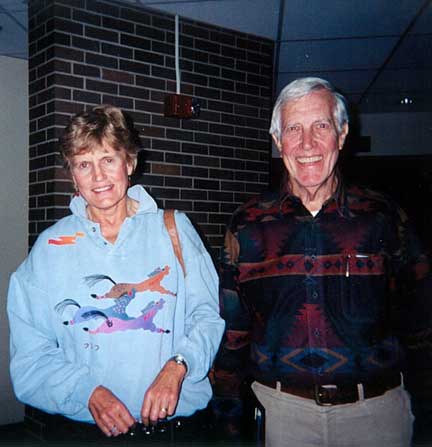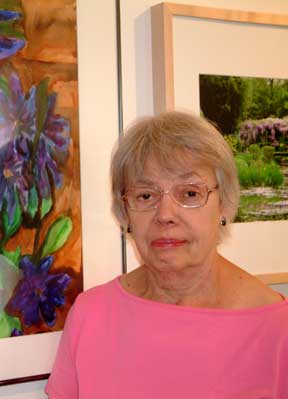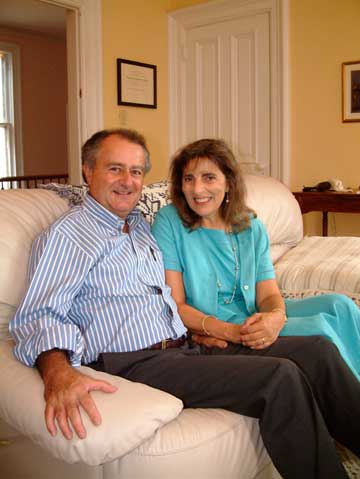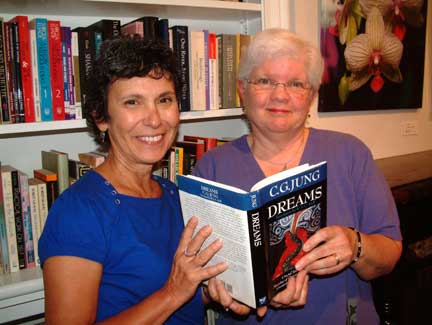
Columbus, Ohio USA
Return to Homepage www.shortnorth.com
C.G. Jung Association of Central Ohio
Celebrates 20 Years of Spiritual Reflection
by Jennifer Hambrick
September 2009 Issue
See Also: Richard Sweeney and the JungHaus
Return to Features Index
© Photos by Gus Brunsman III
JungHaus, 59 West Third Ave., is a center for studying the mind and spirit, for creating and displaying art, for attending programs that inform, uplift, heal, and bring focus to life. For Ann Murtha, the teachings of Swiss psychoanalyst Carl Jung held the promise that something deep within the human mind and soul had the power to bring people together.
“The idea of the collective unconscious, that our psyches throughout time and culture share similar archetypal images that bring us all together and have the potential for commonality of humanity instead of all the divisions that have led to wars. That idea of the collective unconscious called me to his teaching.”
Murtha, 70, may have been unwittingly tapping into this mysterious web of interconnections twenty years ago when, at the request of a small group of people, most of them members of Columbus’ First Community Church, she and her husband, Robert Murtha, formed a Jungian study group. That group later became the C. G. Jung Association of Central Ohio (JACO), which this year celebrates two decades of bringing people together to explore Jung’s teachings on spiritual growth, personal development and other life puzzles.
JACO’s twentieth anniversary celebration is linked with the 100th anniversary of First Community Church, where most of the association’s founders and many of its later trustees were members. First Community Church will host an open house honoring former First Community Church members and JACO founders Ann and Bob Murtha on Sept. 27, at 2 p.m.
The Jung Association’s anniversary festivities continue in October when Jung authority Robert Moore, distinguished service professor of psychology, psychoanalysis and spirituality at the Graduate Center of the Chicago Theological Seminary, will deliver the Jung Association’s 2009 Bollingen Lecture, “A Neo-Jungian Mapping of the Psyche,” on Friday, Oct. 16 at 7 p.m. On Saturday, Oct. 17, Moore also will lead an all-day workshop on “Archetypes and Ecstasy: The Quest for Optimal Experience,” in which participants will have a chance to engage in exercises to uncover patterns inhibiting progress in their quests for “something more.” Both events will take place on the Cambridge Boulevard Campus of First Community Church.
JACO might never have been founded were it not for Ann and Bob Murtha. The story of how they met, married and came to found the association is so tightly entwined with the founding of JACO that the Murthas themselves consider it one rich series of significant convergences – or synchronicities, in Jung-speak – that were simply destined to happen.
Synchronicities: The Founding of JACO
It’s not too bold to say that Jung brought Ann and Bob Murtha together.
While living and working in the New York City area in the late 1970s and early 1980s, Ann Murtha studied Jungian psychology at the Jung Institute of New York and made two study trips to the international epicenter of Jung studies, the C. G. Jung-Institut in Zürich, Switzerland. In 1984 she attended a Jungian retreat in Pennsylvania. The subject of the retreat was Jung’s concept of individuation, which Columbus Senior Jungian Analyst and JACO trustee Dr. Richard Sweeney describes as Jung’s theory of the process of becoming more fully the authentic individual one is called to be.
Perhaps ironically, that retreat on individuation is where Murtha met her other half. Columbus resident Bob Murtha had developed an interest in Jung’s philosophies after years earlier learning about the anima – what Jung called the inner feminine – at First Community Church. Today Ann Murtha marvels at what she believes was the synchronicity – the convergence of events that at first blush seems to be coincidence, but to which Jung’s theories ascribe greater and more ordered significance – of meeting her future husband: his learning about Jung at First Community Church, his becoming interested in Jung’s theories, Ann’s taking a course in Jungian psychology while a student at UC-Berkeley, her becoming interested enough in Jung’s theories to incorporate Jungian theories in her work as a therapist, and their attending the Jungian retreat in Pennsylvania.
Ann and Robert Murtha © Family photo “So, synchronistically we met,” Ann Murtha said.
If the Murthas’ meeting (and later marrying) was the first in the garland of synchronicities that led to JACO’s founding, the second synchronicity occurred when the Murthas moved to Columbus in 1987. Ann left the New York area in 1985 when Bob’s job took them to Dallas, Texas, then the pair came to Columbus two years later. Ann sought a Jungian community in Columbus to replace the vibrant one she had left behind in New York and was disappointed to find none.
“I knew that both coasts were far ahead (of the Midwest) in psychology and spirituality, but I was surprised that there was no Jungian presence at all in Columbus,” Murtha said.
A small group – at first, about ten couples – of First Community Church members learned of the Murthas’ interest in Jung and asked them to lead a study group. Shortly after settling into their Neil Avenue home, the Murthas began hosting monthly Sunday evening gatherings in which the group listened to cassette tapes and worked through workbooks from the Centerpoint Foundation, an organization devoted to learning by incorporating Jungian concepts and approaches.
More and more people – including a coterie of academics from various disciplines who, because of the scientific community’s general disavowal of Jung’s theories, came to be called by others in the study group “the closet Jungians of Columbus” – asked if they could join in.
“We could not take any more in our house,” Murtha said.
In December 1989, the Murthas staged a public event in the more spacious basement of King Avenue Methodist Church. They organized a screening of the BBC’s three-part documentary The Story of Carl Gustav Jung, to be followed by a panel discussion among Ohio Dominican University English professor Mary Jo Myers, OSU professor of education Robert Bargar, Methodist Theological Seminary of Central Ohio theology professor Jeffrey Hopper and Nancy Grimes, a Cincinnati-based Jungian analyst who at that time was the only Jungian analyst in Ohio. The Murthas announced the event in The Columbus Dispatch, but didn’t have high expectations.
“We thought maybe 35 or 40 people would show up,” Ann Murtha said. “It turned out to be a snowy time of year, very poor weather.”
Artist Claire Hagen Bauza introduced the idea of the art gallery as a forum for self-expression at JACO. The gallery concept was established in 1990 featuring primarily local artists whose work reveals their journeys of individuation. More than 100 people attended. After the panel discussion, the Murthas circulated a form asking attendees if they would like to be part of an informal organization devoted to exploring Jung’s teachings. When three-quarters of the respondents answered “yes,” Murtha knew she was at the vortex of a movement stronger than she had ever anticipated.
“That we met, that (Bob) was from Columbus, that he was a member of First Community Church, that when we came it was at a time when (others from) First Community Church were searching for this – there was something bigger going on there. It was meant to be,” Ann Murtha said.
The group incorporated itself as a non-profit organization and set up a board of directors. They rented space in a small house on Lincoln Street for the administrative offices of their still loosely assembled organization. In 1989, the Jung Association of Central Ohio was born.Art and Archetypes: JungHaus Gallery
JACO’s programming lagged only slightly behind its formation. The association offered its first public programs in 1990, starting with a seminar at the Ohio Union exploring Jung’s approach to analyzing dreams. JACO’s art gallery also was established that year, at a time when the Short North was still a fledgling art gallery district.
But the gallery wasn’t part of Ann Murtha’s original vision for the organization. Claire Hagen Bauza, an artist who also curated the art gallery at Fort Hayes High School and was among the early members of the Murthas’ Jung study group, first mentioned the idea of incorporating an art gallery – and thus a forum for self-expression – into JACO’s ethereal mission to provide educational assistance for individuals in their process toward individuation.
“Carl Jung himself was very interested in art and was a wonderful artist himself for a short period of time. And Ann and Bob (Murtha) were totally supportive of (JACO’s having an art gallery), as was the board, because we knew that Jung himself felt that the creative outlets of music and art and other ways of expressing the psyche through dreams and all kinds of different ways are very important,” Bauza said.
Ann Murtha was so supportive of the idea of the art gallery concept that she considers Bauza’s idea – and her membership in the early Jung study group – yet another synchronicity in JACO’s formation.
“(Bauza) had the vision of the art gallery, which was thrilling, because Jung’s whole concept of archetypes and symbols and myths and all of that draws on images, and art is nothing but images. So the addition of Claire’s vision for an art gallery, and being an artist herself, that was a third synchronicity in my opinion.”
Richard and Ellen Kandoian Sweeney arrived in Columbus in 1994 to
become the first Jungian analysts to practice here. The Sweeneys and other Jungian analysts currently run practices independently of each other out of space at JungHaus where JACO is located.Since 1990, JACO’s art gallery has been a venue for many aspiring and established artists who, though not all necessarily avowedly Jungian in their approaches to art and life, have found themselves exploring many of the themes Jung explored in his life journey and expounded upon in his theories: the power of a shared human catalogue of images and symbols in the process of spiritual inquiry and personal individuation, the nature of dreams and their connection with creative and spiritual processes, the exploration of all aspects of human experience and the human psyche along the path of personal growth.
This month and through October, as JACO’s twentieth anniversary festivities get underway, artwork by Columbus artist Jesse Chandler will be on display at JungHaus in an exhibition titled “Totem & Taboo.” The exhibition’s title references the 1913 collection of essays Totem and Taboo by Jung’s onetime mentor Sigmund Freud. But Chandler considers herself neither a Freudian nor a Jungian artist, even though she says Jung’s theories do inform her work as a painter, sculptor and mixed-media artist. Chandler says she aims in her artwork to sanctify the female form and the various concepts it represents. To this end, she interprets Jung’s theories as encouraging a form of self-understanding in which each individual can come to embrace masculine and feminine aspects of his or her own psyche, aspects that may emerge in unexpected ways through the unconscious. Chandler says the artworks in “Totem & Taboo” transform the notion of a culturally fetishized female form, taboo because of its presumed sexual dirtiness, into a form whose many aspects – intellectual and sensual – are not only not taboo or fetish objects, but are actually worthy of veneration.
“I like to think of my work as really embracing the puzzle that is the unconscious,” Chandler said. “I don’t know if this is his intention – I know that he worked a lot with the notion of male and female within his theoretical framework, but I like to think that a lot of that bubbles up eventually from the unconscious. The intuitive piece is inherently female and (that) kind of intelligence gets pushed to the back of the bus. I think (Jung) saw things in much more egalitarian terms. It is in keeping with honoring the different part of yourself, the male and female parts of yourself.”
JACO Director Gina Peacock (Left), with Board member Donice Wooster who serves as director of early childhood ministries at First Community Church. The two organizations share a common mission: to foster individuals’ spiritual growth. JACO Today, Jung Tomorrow
By 1993, JACO was an established presence in Columbus, but there still was room for growth. Murtha wanted to bring someone to Columbus who could guide JACO’s development as an organization.
“My desire was to have a Jungian analyst in Columbus that would provide ongoing stability for the group in terms of Jungian theory,” Murtha said.
Murtha wrote the C. G. Jung-Institut in Zurich, Switzerland, to ask if any of their newly minted Jungian analysts would be interested in relocating to Columbus and beginning their careers at JACO. A native of Springfield and former resident of Cincinnati, Richard Sweeney answered the call and in 1994 established a practice as Columbus’ first Jungian analyst. Six months later, Sweeney’s wife, Ellen Kandoian Sweeney, completed her studies at the Jung-Institut and established her practice as a Jungian analyst in Columbus. They rented office space in JungHaus’ second location on Russell St., and in 2004 purchased the building on West Third Avenue that since then has housed JACO’s offices. Today, the Sweeneys and Columbus’ other Jungian analysts run practices independently of each other out of space at JungHaus and, through their work, help fulfill JACO’s mission as an educational organization devoted to the study of Carl Jung’s theories.
Though the Murthas now live in Colorado, JACO lives on in Columbus in a close association with First Community Church. At its 100th anniversary, First Community Church staff and clergy continue to serve as JACO trustees and the church continues to make its space available for JACO’s large group functions. Sweeney says the two organizations share a common mission: to foster individuals’ spiritual growth.
“First Community Church has always had a serious commitment to programs addressing ongoing spiritual growth and development and in this respect has supported the programs of the Jung Association,” Richard Sweeney said. Donice Wooster, director of early childhood ministries at First Community Church and a Jung Association trustee, says the connection between psychology and spirituality at the core of Jung’s teachings continues to resonate with many First Community Church members today.
“(Jung) once said, in the second half of life all psychological questions are really spiritual questions,” Wooster said. “Jung believed that there were deep archetypal patterns in our unconscious that move us towards wholeness. There’s always been a portion of the First Community Church membership for whom that path of psychology and spirituality as partners has been important.”
How an individual develops spiritually and psychologically is a slippery question, and spiritual questioning and the pursuit of personal wholeness often lead seekers to any number of psychological approaches, including that of Carl Jung.
“Persons, including psychotherapists, continue to look for an approach to psychotherapy that looks ‘more deeply’ into the meaning of the conflicts and dynamics at work in our lives,” Sweeney said. “Some of them want to approach the issues people struggle with with more consideration of questions about the meaning and purpose of life. Some psychotherapists also come to believe that the psyche itself contains the wisdom that can guide us to greater meaning and purpose. This may lead them to look at Jung.”
It may also be one reason why general interest in Jung’s psychological theories is on the rise. Most major U.S. cities now have some kind of organization devoted to Jung’s teachings, and, like JACO, these organizations draw people from all walks of life. And the more interest in Jungian thought grows, the more diverse that field of inquiry is likely to become.
“Many of these people have a genuine interest in culture, art, spirituality and religion, and they believe that Jung’s thinking and view of the psyche or soul has much to contribute to their own personal searches and to their reflection upon social and global issues,” Sweeney said. “For this reason, I think the interest in Jung will continue to grow and will encompass much more than a particular method of psychotherapy.”The C.G. Jung Association of Central Ohio is located in the JungHaus at 59 W. Third Ave. For more information, visit the Web site at www.jungcentralohio.org, call 614-291-8050 or email jungaco@core.com
See Also: Richard Sweeney and the JungHaus
© 2009 Short North Gazette, Columbus, Ohio. All rights reserved.
Return to Homepage www.shortnorth.com




